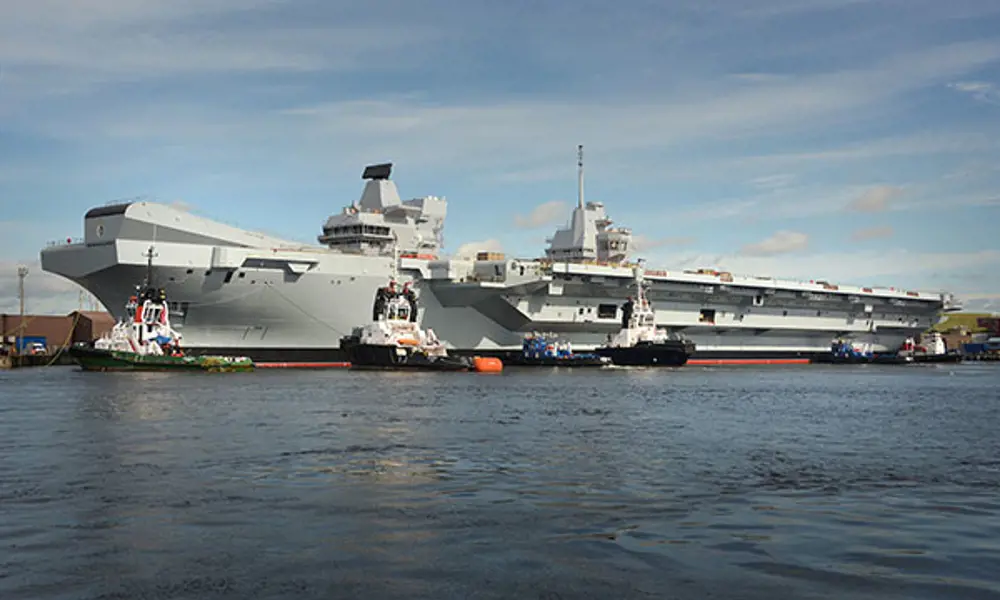
Building Britain's biggest warships
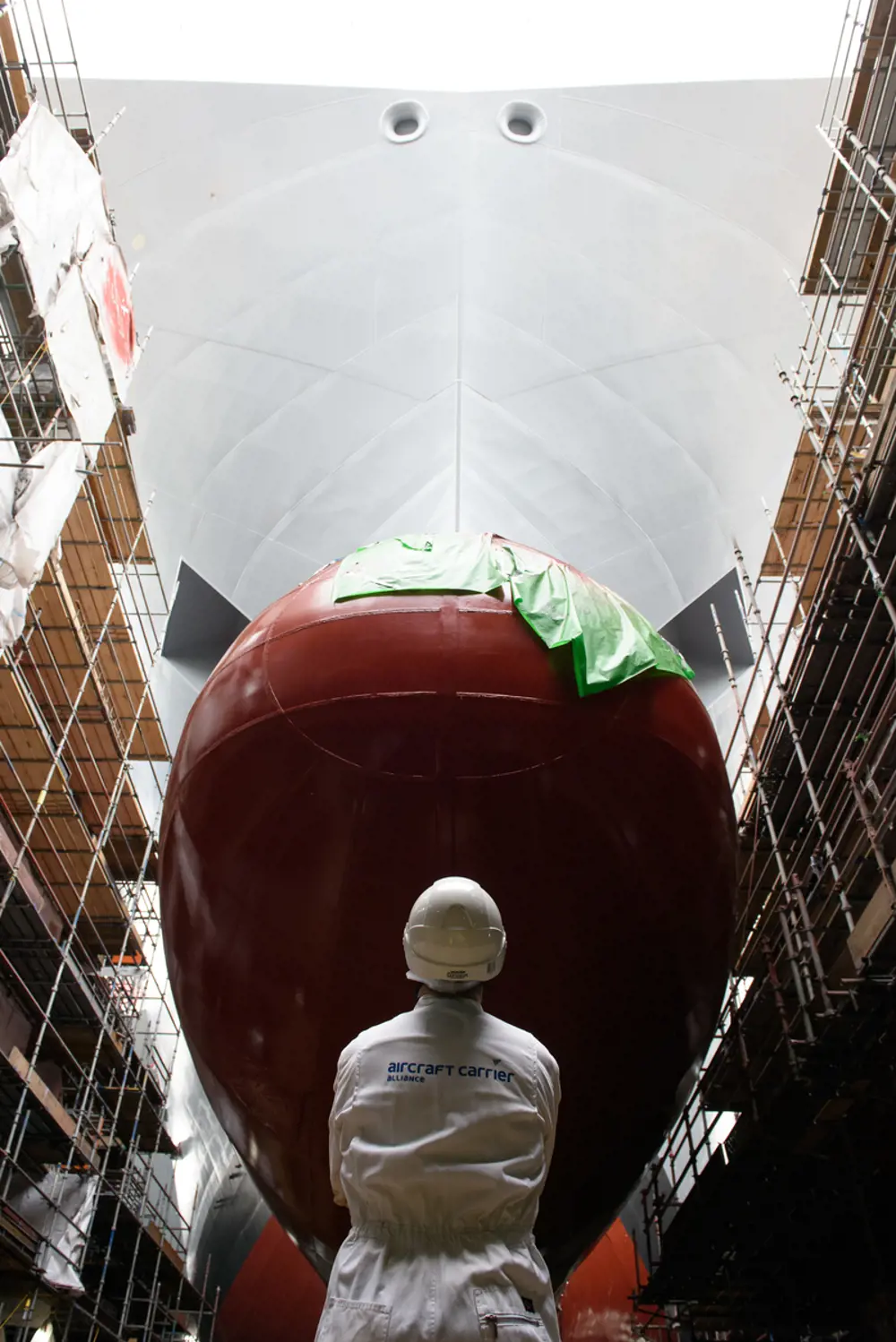
The view of the bow from underneath HMS Prince of Wales, currently undergoing assembly in Rosyth © Aircraft Carrier Alliance
Standing beneath the enormous curving hull of the new HMS Queen Elizabeth, it is easy to summon the spirit of Britain’s mighty naval past. The ships that once glided into the water from dockyards around the country enabled this small island to become a naval superpower that dominated the oceans.
Today, Britannia may not exactly rule the waves anymore, but this does not mean its time as a great seagoing nation has come to an end. The UK is still an island nation, and roughly 95% of the country’s economic activity still depends on the ocean, according to figures from the Royal Navy.
Britain is currently undertaking the most ambitious shipbuilding project it has ever attempted. The HMS Queen Elizabeth and HMS Prince of Wales aircraft carriers are the largest warships to ever be constructed in Britain.
Weighing more than 65,000 tonnes each, they are more than three times the weight of the old Invincible Class aircraft carriers that they are replacing. After nearly 16 years of planning and construction, HMS Queen Elizabeth is almost complete. In 2014, it was moved from the dock in Rosyth, Fife, to a nearby jetty where it is now having the final equipment installed.
It is an impressive sight. From keel to masthead, HMS Queen Elizabeth towers 56 m in height, taller than Niagara Falls in North America. The overhanging hull supports a flight deck covering 4.5 acres – more than two and a half times the size of the pitch at Wembley Stadium.
Floating in the non-tidal basin at Rosyth Dockyard, HMS Queen Elizabeth’s propulsion and radar systems are currently being set to work. The crew is due to move on board at the beginning of 2017, ahead of sea trials a few months later. Yet getting to this point has involved a monumental feat of engineering. Initial design work for the Queen Elizabeth Class aircraft carriers began in 1999, following the Strategic Defence Review the previous year. This had underlined the need for more agile and flexible armed forces to cope with the diverse threats the UK now faces. The aircraft carrier was seen as being central to delivering this capability.
To provide this new flexibility, the ships have been designed with a series of innovative features and new technologies. Perhaps most distinctive is the ‘twin island’ approach that has separated the bridge and flight command centres.
Rather than the traditional single tower on the flight deck used on all other aircraft carriers in the world, HMS Queen Elizabeth and HMS Prince of Wales have two separate command towers
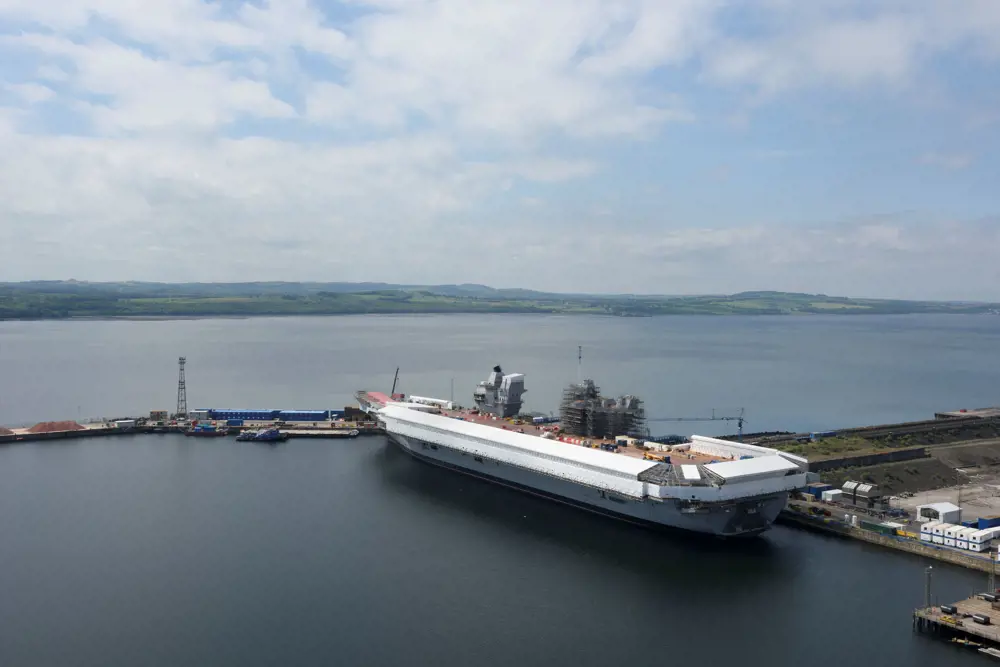
Now structurally complete and fitted out, HMS Queen Elizabeth is undergoing final commissioning in Rosyth, Fife © Aircraft Carrier Alliance
Rather than the traditional single tower on the flight deck used on all other aircraft carriers in the world, HMS Queen Elizabeth and HMS Prince of Wales have two separate command towers: the forward island houses the bridge, while the aft will be responsible for air operations and air traffic control.
This innovative design provides two key benefits. First, it makes the vessel far more resilient to damage as each island is designed to switch functionality, meaning if one is put out of action, the other can be used to perform both roles. Inside each are multifunction screens that can provide all the information needed for running the ship. Separating the command nodes in this way also gives the flight command, or FLYCO as it is known, an unhindered view of the flying operations.
Each of the 30 m high islands has also been designed to reduce the radar signature it generates. While it is virtually impossible to hide a vessel the size of an aircraft carrier – particularly when it has two large aircraft lifts on the side – the external panels on the islands are angled to deflect radar signals, drawing on some of the lessons learned from the Type 45 destroyers they will eventually operate alongside.
Another of the lessons learned from the Type 45s was in the process of constructing the vessels themselves. The bows of these cutting-edge destroyers were built at a separate shipyard to the rest of the vessels before later being slotted into place.
Construction across six sites
With a project as large as the Queen Elizabeth Class aircraft carrier programme, it was clear that no single shipyard was going to be large enough to build the ship in its entirety. So rather than using the traditional keel-up approach to shipbuilding, the aircraft carrier was divided into blocks that were constructed at different shipyards around the country before being brought together at Rosyth.
In all, six separate shipyards owned by four different companies have built major sections of HMS Queen Elizabeth, and subsequently HMS Prince of Wales. Rosyth was chosen as the yard where the ships were assembled, as its dock was the only one big enough to take the vessels. A 68 m tall crane – with the biggest lift capacity in the UK at 1,000 tonnes – was commissioned specifically for the project.
Standing in the empty dock is an intimidating exercise – the huge open space between the dock walls and gate tower above gives a sense of the sheer pressure of water being held back. As the segments of first HMS Queen Elizabeth, and then later HMS Prince of Wales, were gradually assembled, the almost agoraphobic sensation of the dock was replaced with a feeling of claustrophobia as the vast steel structures blocked out all natural light beneath the 280 m long and 73 m wide vessel.
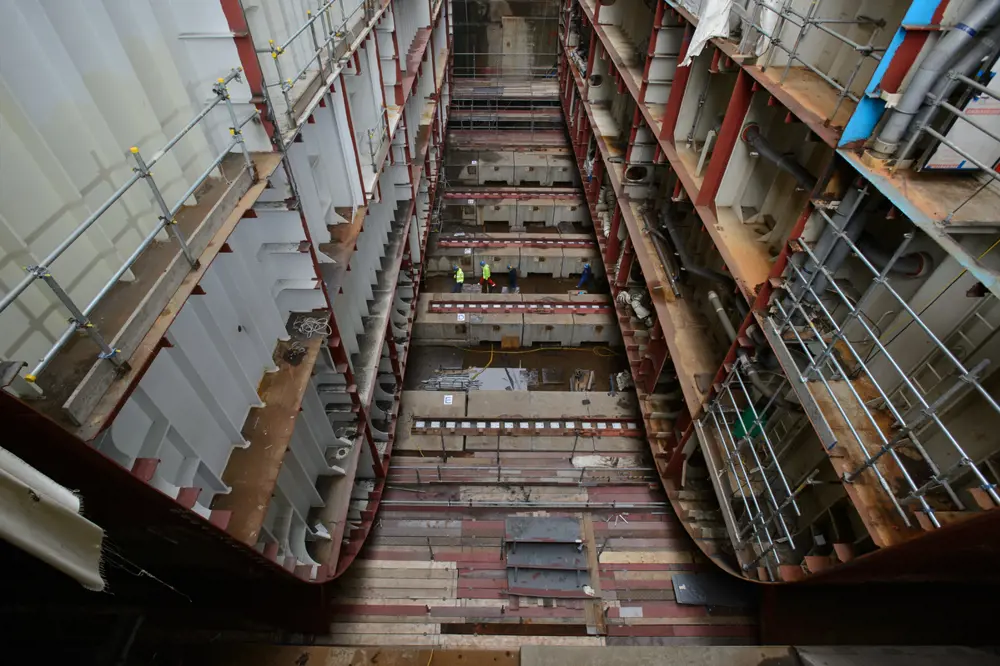
Each of the aircraft carriers have been built in blocks at separate dockyards around the UK before being brought to Rosyth to be pieced together. Massive sections of the aircraft carrier were ‘skidded together’ with millimetre accuracy. This world record saw 25,000 tonnes of ship moved back more than 17 m © Aircraft Carrier Alliance
Each of the enormous segments of the aircraft carriers, built from a total of more than 100,000 tonnes of steel, needed to be precisely engineered to identical standards to ensure every section of deck, every corridor, every doorway and every bolthole lined up. To help ensure this, 3D computer-aided design systems were used to build a virtual prototype of the entire ship that was then used across the entire supply chain.
Delivered to Rosyth by barge, the blocks were pieced together like a giant 3D jigsaw puzzle. The dock itself could be separated into sections, allowing just parts of it to be filled with water, so that the segments could then be floated into place.
Installing the largest section of each vessel – an 11,500-tonne piece known as lower block four – meant flooding half of the dock while the bow half of the vessel remained dry behind a removable gate. The new block was floated into place before the water was removed and the 25,000-tonne bow segments were skidded back to meet the new piece.
Bringing these sections together was only the beginning. There is a significant amount of welding needed to make the pieces structurally complete and then to join up the services, such as heating, ventilation and air conditioning, pipework and electrical cables. To turn these fitted-out blocks into working warships requires about 18 months of fit-out and commissioning.
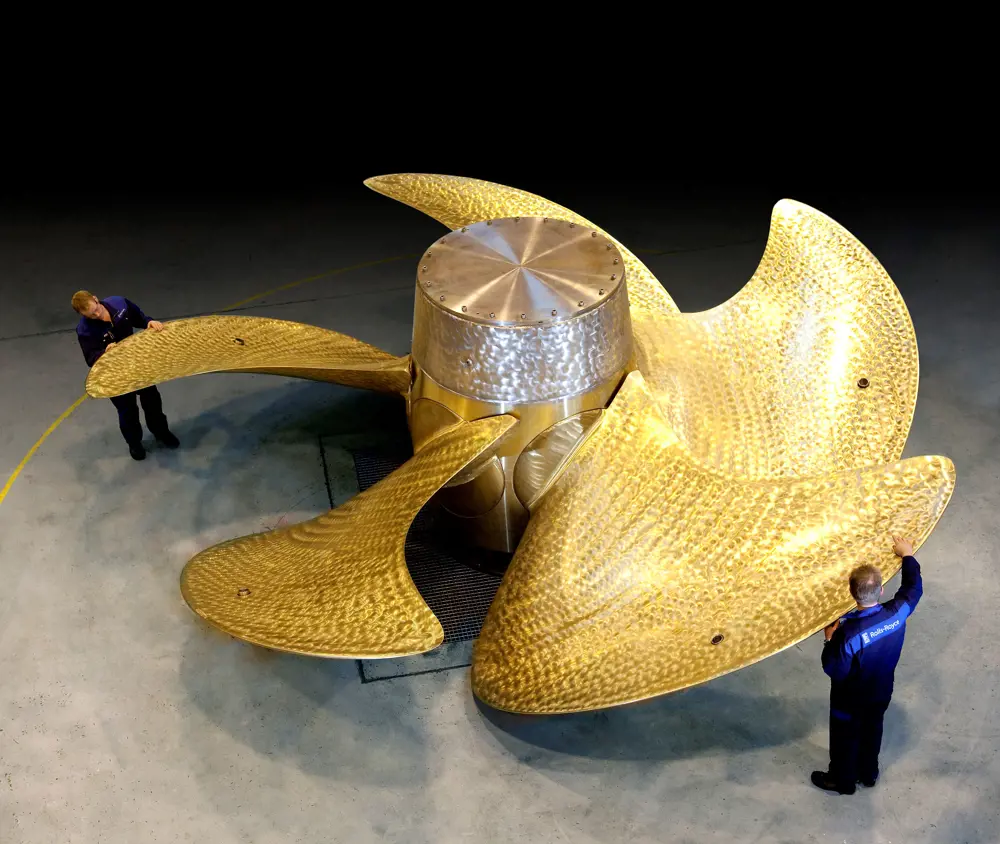
Two 33-tonne propellers, one of which is pictured above, will drive HMS Queen Elizabeth and HMS Prince of Wales through the water. They have been designed so their pitch can be modified to aid propulsion through the water © Rolls-Royce
Engine power
Powering each carrier are two Rolls-Royce MT30 gas turbines and four diesel generators capable of producing a combined power output of 110 MW, enough to power a large town. This is used to drive the vessels’ electric propulsion system through twin shafts, each with two 20 MW general electric motors that can be operated individually or in tandem to achieve a maximum speed of 25 knots.
At the end of each shaft sit 33 tonnes of propeller, designed with five blades that can have their pitch angle adjusted to match the speed requirements of the vessels as they are upgraded through their lifetime. Individual blades can also be replaced underwater if they become damaged, reducing the need for the vessel to be dry-docked.
Each nickel-aluminium bronze propeller delivers around 50,000 horsepower, yet, unusually, they have been designed in tandem with the twin rudders so they can work together to increase the torque they produce in the water.
The rudders themselves have been given a twisted design to help reduce the vibrations that can occur as bubbles produced by the spinning propellers collapse onto their metal surface – an effect known as cavitation (‘Quieter, more efficient propellers’, Ingenia 65).
An enormous bulb on the bow beneath the waterline will also help ensure that the huge vessels can slip through the water more smoothly.
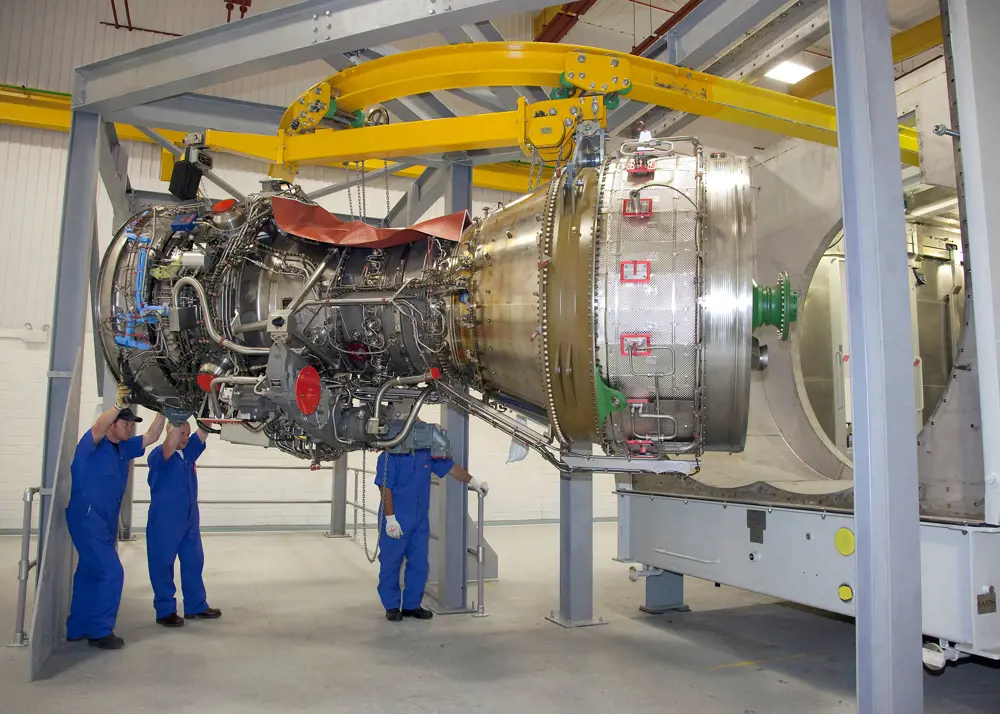
Each of the aircraft carriers is powered by two Rolls-Royce MT30 gas turbines and four diesel generators, which together produce a combined output of 110 MW. One of the MT30 gas turbines is pictured above © Rolls-Royce
Joined-up systems
Inside HMS Queen Elizabeth, more than 320,000 km (198,838 miles) of electrical cables and 8,000 km (4,970 miles) of optical fibres have been installed to link up the networks of communications, control and IT systems on board.
Splitting the command between two islands has meant that the same information about the propulsion system, the radar, the weather, the wind, and the ship’s heading and speed, together with all communications, need to reach both at the same time. Additionally, an operations room deep within the ship also needs to be linked to this same set of data.
To achieve this, a novel, integrated system has been developed to communicate information throughout the ship, split between an administrative network, a system that controls the ship and a third protected system that is responsible for the management of the aircraft, onboard sensors and weapons systems.
Technology has also helped to deliver another key requirement for these modern aircraft carriers: allowing fewer crew members to achieve more. With a crew of just 679, HMS Queen Elizabeth will have just 29 more in its company than the much smaller Invincible Class aircraft carriers. When fully laden, it will be carrying 36 of the new F-35B Lightning II aircrafts and four Crowsnest helicopters, along with nearly 1,000 air crew.
Much of this is made possible by an innovative munitions handling system. In what is the first naval use of a system more commonly seen in land-based warehouses. The highly mechanised weapons handling system moves pallets of munitions from the magazines deep in the ship to a weapons preparation area and then onto the flight deck where they can be fitted to the aircraft.
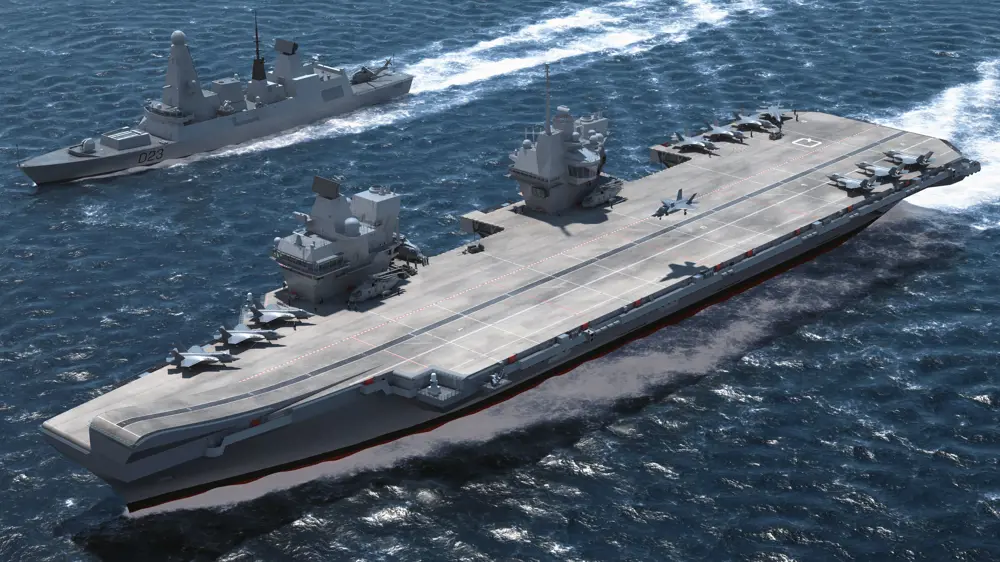
HMS Queen Elizabeth, illustrated above alongside the new Type 45 destroyer, will become the nation’s flagship alongside HMS Prince of Wales © Aircraft Carrier Alliance
It works much like the robotic systems used in modern large-scale logistics centres, where orders are moved around by machine before being packaged.
The system on the Queen Elizabeth Class aircraft carriers, housed within a supermarketsized area, uses 56 ‘moles’ that lift and move a payload along a complex network of rails fixed throughout the ship.
Thanks to the moles, the ship’s magazines are completely unmanned and are instead controlled from a central location. The moles themselves have been designed so that two different versions work in tandem: one to traverse forward and aft, and another that moves between port and starboard. The two types are different shapes to allow the packets of munitions to be lifted and carried in the correct orientation.
Each mole has a predetermined area of travel, and they can transfer payloads between each other, transporting the weapons from the magazine to the preparation area in a kind of moving mechanised version of pass the parcel.
Electrical lifts and drives ensure that the potentially dangerous pallets are precisely stowed and positioned as they are moved. A series of lifts connect the magazines to the hangar, weapons preparation area, and flight deck, and a unique mechanism enables the mole to access the lift platform without needing to disengage and re-engage from the rail system.
Yet it is not just the handling of weapons that has allowed the crew to be streamlined and freed up for other duties. Even the ship’s four galleys have been specifically designed to allow food to flow from storage, through the preparation areas to cooking and onto plates as quickly and efficiently as possible. Just 67 catering staff will be able to feed the entire ship’s crew and the largest galley has the capacity to serve 960 crew members in just one hour. To ensure the crew has a supply of fresh water while at sea, a £1 million reverse osmosis system will draw in sea water and produce 500 tonnes of fresh water a day.
Unlike any other ship in the Royal Navy, HMS Queen Elizabeth even has its own bakery on board, capable of producing 1,000 loaves of bread a day. The crew will be able to start and end their day with the smell of fresh bread wafting from the bakery as they arrive at the dining halls.
Unlike any other ship in the Royal Navy, HMS Queen Elizabeth even has its own bakery on board, capable of producing 1,000 loaves of bread a day
Many systems onboard – even down to the waste handling system – have been automated as much as possible to reduce the burden on the crew. The vessel has an expected lifespan of 50 years, so there has also been an emphasis on ensuring the technology on board is at the cutting edge. Unlike the old aircraft carriers, the Queen Elizabeth Class will be making extensive use of wireless communications throughout the vessel to allow the crew and the teams on the flight deck to move around with their hands free.
These wireless communications are provided using terrestrial trunked radio (TETRA), which can communicate directly and via base stations. Around 500 handsets will be provided for above- and belowdeck communications for mobile teams.
The majority of the communications on board will be handled by a tactical command and control voice system (TC2V), while there is also a voice over IP system and 183 self-powered telephones to provide a backup should the other systems fail.
Their modular design will also help the vessels to stay up to date as they age. In 50 years, technology can change dramatically – just look at the 40-year evolution of the desktop computer into handheld devices that fit into our pockets.
In both HMS Queen Elizabeth and HMS Prince of Wales, redundancy has been built into areas of the vessel where new equipment can be installed as technology progresses.
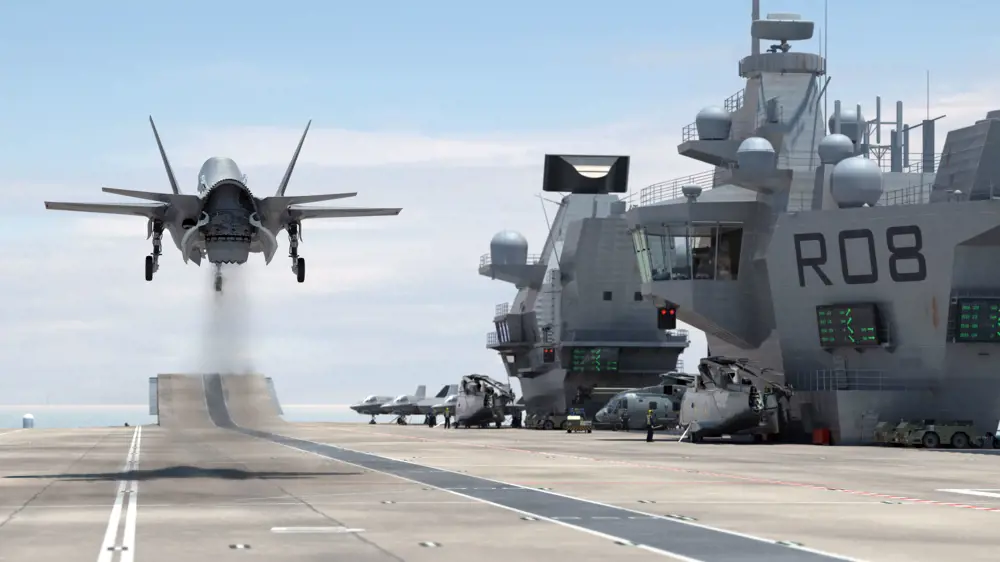
Each vessel will carry 36 of the new F-35B short take-off and vertical landing jets. The exhaust jet produced by these aircraft has meant engineers have had to develop an entirely new deck coating to protect it from the extreme heat © Aircraft Carrier Alliance
Fit for aircraft
On the flight deck, there is the ability to install catapults and restraint cabling should the aircraft onboard also change. HMS Queen Elizabeth is due to carry the short take-off and vertical landing version of the F-35B supersonic stealth jets, and so it has a ramp built on the front of the platform. Fitted with an engine that can swivel 90 degrees and a LiftFan engine under its belly, the F-35B can take off and land without the need for any assistance.
However, early in the vessel’s design, there was an expectation that it might have been equipped to carry the normal version of the F-35, which requires a catapult and restraining system to prevent it from pitching over the side into the sea, and so there are still spaces on the deck, and internally, where these could be accommodated in the future.
To cope with the extreme heat generated by aircraft engines, a new type of coating has had to be developed to protect the decks. Normally the flight decks of aircraft carriers are coated with an anti-slip paint to prevent aircraft from losing control as they take off and land, while also keeping the crew safe.
The jet exhaust gases from the F-35B, which can reach temperatures of more than 920°C, have been found to quickly degrade the standard coatings, so an experimental non-skid thermal metal spray is being used in key areas of the deck to protect it.
The jet exhaust gases from the F-35B, which can reach temperatures of more than 920°C, have been found to quickly degrade the standard coatings
This is a layer of molten metal that bonds to the deck as it cools and provides a raised surface to prevent skidding. However, it needs to be applied at exactly the right rate and temperature to ensure that it sets properly. When applied correctly, the coating helps to dissipate the heat produced by the F-35B exhausts and means that the deck will be more resilient.
Although thermal spray has been used before to protect vessels while at sea, on the aircraft carrier it had to combine heat-resistant properties with the drop needed on a flight deck.
A specialist firm, Monitor Coatings, based in North Shields, Tyne and Wear, was awarded the contract to develop the coating, which will ultimately cover more than 19,500 m2 of deck. Many different methods were tested extensively at BAE Systems’ hot gas laboratory in Warton, Lancashire.
The exact formulation of the metal spray is still a closely guarded secret. It was applied using a specially developed low pressure plasma-spraying technique, where powdered metal is fired through a jet of plasma at temperatures of almost 10,000°C (18,000°F) onto the deck.
The molten droplets then flatten and quickly solidify, creating a tough and rough coating 2 to 2.5 mm thick, bonded to the steel beneath. This can provide grip and also cope with the extreme temperatures created by the F-35B exhausts.
In addition to the deck, there are a staggering 370 acres of vessel that have needed painting to help protect the steel from the corrosive ocean environment.
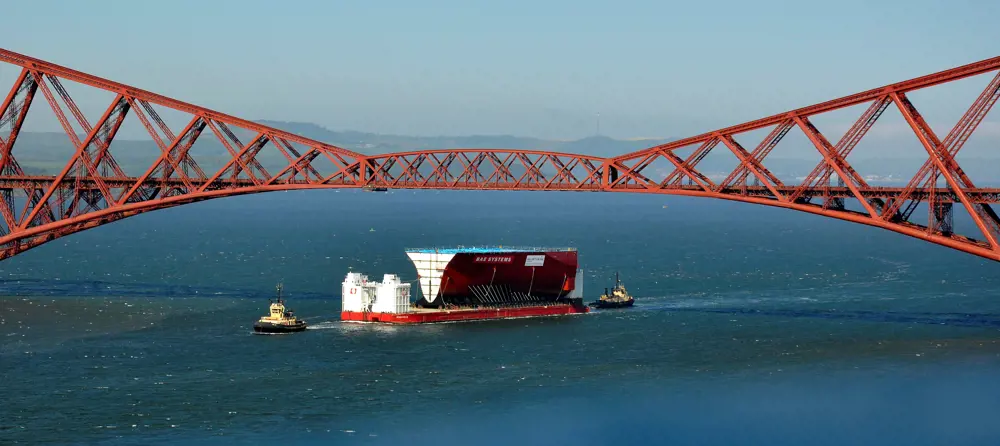
Many of the larger blocks, which have been fitted together like a jigsaw to build each vessel, weighed in excess of 11,000 tonnes and required the world’s biggest submersible barge to transport them around the UK to Rosyth, Fife © Aircraft Carrier Alliance
Navigating the ship
As the crew prepares to take over the HMS Queen Elizabeth, it has already started moving equipment into some of the vessel’s 3,011 compartments. Such is the size, it is easy to become lost in its warren of compartments in the nine decks below the flight deck level. A special platform navigation system has been installed to help those onboard find their way around.
Standard satellite navigation signals cannot penetrate the steel hull, and with many of the compartments hidden deep within the ship away from any windows, another approach was needed.
Quick response (QR) codes have been installed at key points around the vessel so that they can be scanned with a handheld device such as a tablet or a smartphone. Combined with the deck plans and route-finding software, this can reveal a person’s location on the device, and work like a vessel-wide GPS to guide people to where they need to be.
While the new crew will be able to use familiar ship location markings to find their way around, this positioning system also proved vital during construction to prevent workers from getting lost while fitting out the ship.
This technology could also find uses beyond the Queen Elizabeth Class carriers – helping people to navigate large environments such as underground transport networks or even hospitals
Out at sea
HMS Queen Elizabeth is almost ready to leave on its first voyage. The vessel’s two 13-tonne anchors have also been tested for the first time, and its radar has begun turning and has already been tracking aircraft on approach to Glasgow airport, 40 miles to the west of Rosyth. When fully set to work, it will be able to track 1,000 aircraft simultaneously up to 250 miles away.
Ultimately, when it becomes fully operational in 2020, the aircraft carrier will be a home to more than 600 people and a temporary home to a further 1,000. While on board, they will all live, work and potentially fight alongside one another for months at a time. HMS Prince of Wales is due to become operational shortly afterwards in 2023.
Much like the crews of the great Royal Navy warships of the past, those serving on board will be responsible for ensuring the security and livelihood of the British nation for years to come.
***
This article has been adapted from "Building Britain's Biggest Warships", which originally appeared in the print edition of Ingenia 67 (June 2016).
Contributors
Richard Gray
Author
Martin Douglass is Engineering Director at the Aircraft Carrier Alliance and Chief Engineer of the Queen Elizabeth Class aircraft carrier programme. He has previously worked in marine engineering for BAE Systems and the Ministry of Defence, having completed a Bachelor of Engineering in the field. He also holds an MSc in defence acquisition from Cranfield University
Keep up-to-date with Ingenia for free
SubscribeRelated content
Maritime & naval

Modelling ships in danger
Stricken ships in danger of breaking up, sinking, capsizing or losing their fuel or cargo need expert help to be rescued. Lloyd’s Register’s Ship Emergency Response Service (SERS) was set up to provide this support.

Quieter, more efficient propellers
Göran Grunditz, Manager of the Rolls-Royce Hydrodynamics Research Centre, explains the challenges when reducing noise from marine propellers for passengers onboard ships and for military vessels that seek to avoid detection, while maintaining a high thrust per input power and maximising efficiency.
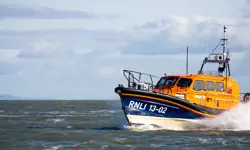
Against the tide
The Royal National Lifeboat Institution introduced the Shannon class all-weather lifeboat in 2014, which uses cutting-edge technology, is faster and more manoeuvrable than existing vessels, and has a quicker and safer launch and recovery system. Read about the design and production of the lifeboat.
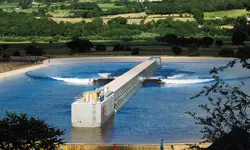
How to create the perfect wave
From small waves lapping at your feet and swells suitable for surfing to storm waves for testing structures and even tsunamis, waves of any shape and any size can now be engineered. What are the techniques and conditions needed to model waves and what makes some more powerful than others?
Other content from Ingenia
Quick read

- Environment & sustainability
- Opinion
A young engineer’s perspective on the good, the bad and the ugly of COP27

- Environment & sustainability
- Issue 95
How do we pay for net zero technologies?
Quick read

- Transport
- Mechanical
- How I got here
Electrifying trains and STEMAZING outreach

- Civil & structural
- Environment & sustainability
- Issue 95